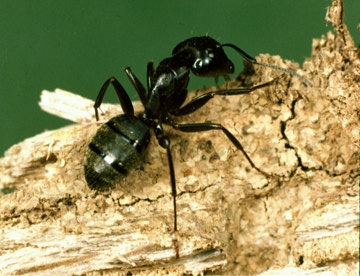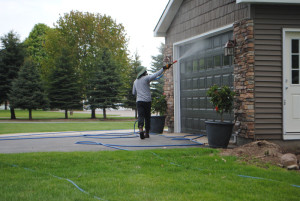The brown marmorated stink bug, otherwise abbreviated as BMSB, is an invasive species; as it was introduced to the US from Eastern Asia in the mid-90s. It is also known as the East Asian or yellow-brown stink bug. The BMSB was first collected in the United States in Allentown, PA in the fall of 1996, but was not identified until years later in 2001. From there, it quickly spread east. Today, BMSB has been identified in 44 states including Washington DC. The stink bug’s native range includes China, Japan, Korea, and Taiwan.
Stink Bug Odor
BMSB is aptly named by the odor they emit when they feel threatened. It is thought that this odor aids in protecting against predators. The bugs produce the smelly chemical in a gland on their abdomen. Some species can actually spray the several chemical inches. The smell has often been compared to potent herbs like cilantro.
Interestingly enough, the composition of the odor is comprised of chemicals commonly used as food additives and is actually present in cilantro. This smell can linger for hours so it is in your best interest to try to avoid the bugs or carefully sweep or vacuum them up if they have entered your house.
Physical Attributes
Stink bugs are characterized in several different ways. They are described as “large and oval-shaped” and “shield-shaped”. Adult BMSB can reach almost 2 cm in length and are almost as wide as they are long. Their legs extend from their sides, which makes adult bugs appear even larger. The BMSB is brownish in color with lighter bands on their antennae and darker bands on their wings.
Adult stink bugs are strong fliers and fold their wings on top of their body when they land. The wings of nymphs are not fully developed but they do appear as they become an adult. Mature wings are an identifier of adults.
The nymphs are very tiny when they first hatch and are yellow and red in color. As they mature the yellow fades to white. Nymphs have bright red eyes during this stage of their lifecycle. They molt or shed their skin 5 times as they mature. Nymphs become larger each time they molt. By their final molt, the nymphs are almost as large as adult stink bugs.
Habits
In general, adult BMSB feed on fruits and the nymphs feed on leaves, stems, and fruit. The life cycle of BMSB typically involves mating, then reproducing, and feeding from the spring months to late the fall. Upon the cold temperatures, stink bugs seek shelter to spend the winter in a dormant phase known as ‘diapause’.
BMSB search for overwintering sites in late fall before the weather conditions change drastically. They spend the winter in diapause inside homes or buildings, usually within the walls, attics or crawl spaces. However, diapause may not be the total competition of their season. If the weather warms up for long enough, overwintering stink bugs may be misled in thinking it is time to exit diapause and become active once again. Stink bugs will then reemerge in early spring and become active.
BMSB mate and create up to 3 generations per year depending on their habitat. Colder areas only see one generation each year, whereas warmer areas will likely see two or three. Stink bug females typically lay 20 to 30 eggs. These eggs are light green and barrel-shaped, attached side-by-side in a mass on the underside of a host plant’s leaves. The eggs will hatch within four to five days and from there the nymphs will begin to feed.
Signs of an Infestation
In most cases, homeowners will first detect stink bugs by their large invasions in the fall months. Finding large numbers of living or dead stink bugs is also a sign of an infestation. Stink bugs will show themselves on sunny sides of homes where they enjoy warming themselves. Farmers often detect an infestation by the damage caused to their crops.
Threats
The BMSB cannot sting and is also unlikely to bite humans or animals. The stink bug’s mouthparts are grouped into the piercing/sucking category, but they do not use blood as a food source like mosquitoes, bed bugs, or biting flies. Their mouths are not structured in a manner that allows them to bite through human skin.
Stink bugs are relatively harmless to humans, though they do have the potential to spread throughout the country. This could result in harm to the agricultural industry, as they destroy crops. BMSB can cause damage to fruit trees, ornamental plants, and gardens, but they are more of a nuisance pest than an actual threat to humans. They do not spread disease or cause structural damage.
To avoid a potential infestation of these pests, proper exclusion is of the utmost importance. Hogarth’s is well-versed in varying types of exclusion for residential and commercial properties. We will seal entrance holes around pipes, windows, ridge vent and soffits. It is important to note that exclusion alone will not always fix the issue; the home will need to be treated to keep every BMSB away from the structure. Call us today!



